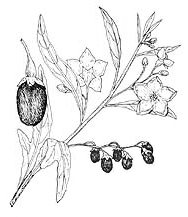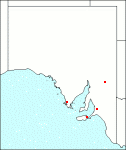Family: Solanaceae
Solanum aviculare
Citation:
Forster f., Plant. Escul. 42, no. 12 (1786).
Synonymy: Not Applicable Common name: Kangaroo apple.
Description:
An erect soft-wooded shrub to 2 m tall, straggly with age, younger stems angular with raised lines, glabrous except for minute simple and glandular hairs on young growth and corolla tips, unarmed; juvenile leaves to 25 x c. 12 cm, elliptic to obovate in outline, pinnatisect with 3-11 lobes deeply divided to within c. 1 cm of the mid-vein, lobes lanceolate or long-triangular; entire leaves to commonly c. 10 x c. 2 cm, lanceolate-elliptic, apex acute to acuminate; petiole 1-1.5 cm long.
Inflorescence a cyme with up to 10 flowers, sometimes divided, from stem forks or leaf axils; peduncle often lacking and floral rhachis to 15 cm long; pedicels to 2 cm long; calyx campanulate, 3-4 mm long, lobes bluntly triangular; corolla 3-4 cm diam., rotate-stellate, lobes broad, interacuminal tissue scarcely exceeding the acumen, shallowly campanulate, bluish-violet; filaments c. 3 mm long; anthers c. 4 mm long, oblong, erect; ovary glabrous; style 7-8 mm long, erect, glabrous; stigma terminal, pale-green.
Fruits commonly c. 2 cm long, 1-1.5 cm diam., obovoid to ellipsoid, at maturity a bright orange-red to scarlet, succulent; seeds c. 1.5 mm long, finely reticulate, reddish-brown, numerous; stone cell masses 1-1.5 mm diam., rounded, rarely conspicuous.

| Flowering and fruiting branch and a fruit.
|
Image source: fig. 573A in Jessop J.P. & Toelken H.R. (Ed.) 1986. Flora of South Australia (4th edn).
|
Published illustration:
Symon (1981) J. Adelaide Bot. Gard. 4:76; Cochrane et al. (1968) Flowers and plants of Victoria, fig. 256.
|
|
Distribution:
|
S.Aust.: EP, SL. Qld; N.S.W.; Vic.; Tas. Native to New Zealand and New Guinea; naturalised in W.Aust., Hawaii and New Caledonia.
|
Conservation status:
naturalised
Flowering time: Jan. (1 record).
|

SA Distribution Map based
on current data relating to
specimens held in the
State Herbarium of South Australia
|
Biology:
No text
Uses:
Occasionally cultivated for its showy fruits or in New Zealand and eastern Europe as a source of solasodine for cortisone and other steroid drugs.
Author:
Not yet available
|

